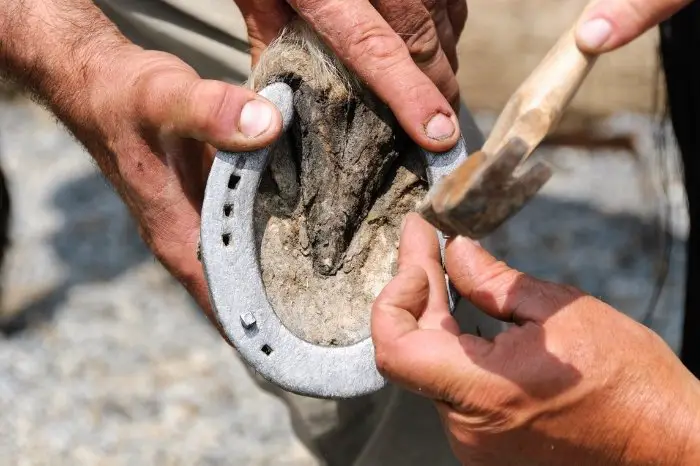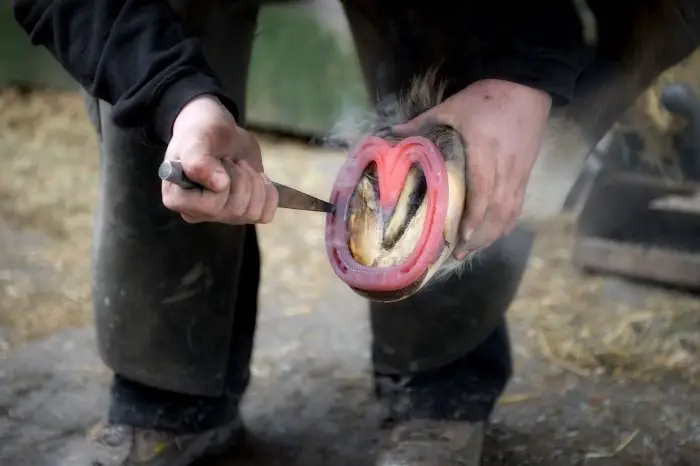Last Updated on March 16, 2022
Hoof care is an essential part of owning a horse, whether you just do regularly trimming or get your horse shod, you will notice different types of horseshoes. To an inexperienced eye, all horseshoes look the same. However, that’s not the case.
What Is A Horseshoe?
A horseshoe is a metal plate in the shape of a ‘U’ that goes on the underside of the hoof. The basic purpose of the shoe is to protect the hoof from various rough surfaces. Some types of modern horseshoes also provide support of the hoof for certain health conditions.

Horse Shoe History
To get a good understanding of horseshoes, knowing a little bit about their history will help learn the differences. The earliest historical records about horseshoes come from the Roman poet Catullus in the 1st century B.C. The earliest horseshoes are not metal but natural materials.
These early shoes were made with plants or leather. The Romans called these shoe hipposandals. However, in Asia, the people also used woven plants as shoes on their horses.
The first metal horseshoes arrived in the 6th or 7th century in Northern Europe. The wet and cold environment did not suit natural shoes, and the horses needed a way to grip this type of ground.
As people integrated horses more and more into life, they discovered that their hooves would break or crack. To combat this and prolong the comfortable use of these horses, the horseshoe was born.
Over the next centuries, the horseshoe changes as knowledge of the hoof increased. The shape and design varied depending on the purpose, such as war, work, or transport. As horse riding became increasingly popular in the early 20th century, the horseshoe market exploded.
Common Types Of Horseshoes
There are several types of horses commonly seen, each with a specific purpose. Horseshoes are handmade from scratch, or the farrier can adjust a pre-made shoe. Here will introduce you to these.
Regular Shoe
A regular horseshoe is a kind you will see the most often. Most of these shoes are pre-made a fit to an individual horse’s hoof with some minor adjustments. This basic shoe is for a normal hoof.
It provides support, and many horses will only ever need this type of horseshoes.
Rim Horseshoes
A rim horseshoe is pretty much the same as a regular shoe. The only difference is the depth of the groove runs along the center of the shoe. This groove helps give the horse a better grip.
It is a popular shoe option for equestrian activities that require quick turns and working at speed.
Franklin Sports Horseshoes Set – Includes 4 Horseshoes and 2 Stakes
Bar Horseshoe
A bar horseshoe is fully enclosed. You will see the regular ‘U’ shape, and instead of a gap at the heel end of the shoe is a metal bar. There are two types of bars shoes, a straight bar, and an egg bar.
Both types of bar shoes provide support to the horse’s heel, leg, and the back of the hoof. You might also see a bar shoe on a horse that has a hoof injury that requires extra help holding the foot together.
An egg bar shoe is curved and not straight across under the heel. It provides more support than a straight bar horseshoe. This is because the bar extends past the heel of the hoof.
Horses with navicular require a special type of shoeing. Watch farrier shoes and explain how this type of horse is shod.
Heart Bar Horse Shoe
The heart bar is similar to other types of bar shoes. In addition to the bar across the heal, it also has a metal plate the covers the frog. This is a specialized shoe that is put on horses that need a lot of support, such as those with laminitis. Most of the time this shoe is also put on with packing or pads to give the horse extra comfort.
Bar shoes can restrict the hoof’s elasticity, are heavier, and are easier for the horse to accidentally pull off. So even though they provide more support, you should only use them if necessary.

Racing Plates
Racing plates are aluminum instead of steel. This makes the shoes much lighter, but far less durable. A racing plate is the same shape as a rim shoe.
Racehorses wear these shoes in a race, as they allow the horse the most freedom to move their feet quickly. They only last for a few days before they need changing.
Horseshoe Types Conclusion
The majority of horses will wear normal shoes. Sometimes the farrier will add plastic or gel pads to provide a little more protection. A skilled farrier will know if your horse needs a different type of shoe and can advise you on general hoof care.
What is a keg horse shoe?
A keg horseshoe is a type of horseshoe that has been made by machine and is available in various sizes as opposed to any horseshoe that is custom-made to fit a specific horse.
Horseshoes have different parts. Foe example, the pointy ends of a horseshoe are called the heels. A keg horseshoe with long heels is called a hot shoe while a keg horseshoe with short heels is called a cold shoe. Cold shoes are more versatile and can be fit to either front or hind hooves.
To make it fit best to most horses, the holes are placed in a way that keg horseshoes can be adapted to more or less any average hoof. The holes are positioned perpendicular to the shoe in either “punched fine” or “punched coarse” manner. The expression “punched fine” refers to the holes that are punched closer to the outside edge of the shoe. When the holes are closer to the inside edge of the shoe, it’s known as “punched coarse.
What is a round horseshoe for?
The most common type of round horseshoe is the straight bar shoe. The straight bar shoe is a commonly used tool for treating various types of hoof disorders and injuries. Quarter cracks and white line disease are just two of the conditions that this horseshoe can help repair by holding the hoof together as it heals.
Unlike a regular horseshoe, a straight bar shoe has an extra bar attached to the back of the shoe in a way that it forms a complete circle. This gives the horse more support on the back of the heel and leg. In addition, it helps to relieve pressure from the foot and to prevent future problems.
What are heart bar shoes for horses?
Heart-bar shoes are a tool used by veterinarians. They can help treat laminitis, a condition that can result in a horse’s hoof being so deformed that it will fail. These shoes allow the hoof to move as it should, similar to how a human foot would move. They mimic the natural movement of a unshod foot as the heel is raised and the sole is lowered when the horse moves his hoof. With the use of heart-bar shoes the frog and wall are restored to a natural pattern of weight bearing. The support the shoes offer to the coffin bone is of the outmost importance for speedy recovery and realignment.
Do horses need shoes for trail riding?
Horses used for trail riding need to have horseshoes. If you want your horse to perform well on uneven surfaces such as dirt, rock, sand, mud, and the like, you should consider getting the horseshoes for your horse.
Horses that use the trail are known as hack horses and their hooves need to be cared for to ensure there are no problems with the feet and legs of your horse. Horse shoes, especially those worn by horses in rough terrain, help horses stay in shape by providing the hoof protection that is appropriate for the conditions that are encountered. This is specially important when the trail rides are done on a paved surface or hard-packed ground. Without the horseshoes the hooves can wear away faster than they grow!
Michael Dehaan is a passionate horse owner, horse rider, and lover of all things equine. He has been around horses since he was a child, and has grown to become an expert in the field. He has owned and ridden a variety of horses of different breeds, and has trained many to compete in shows and competitions. He is an experienced horseman, having worked with and competed many horses, including his own. He is an active member of the equestrian community, participating in events and teaching riding lessons.

